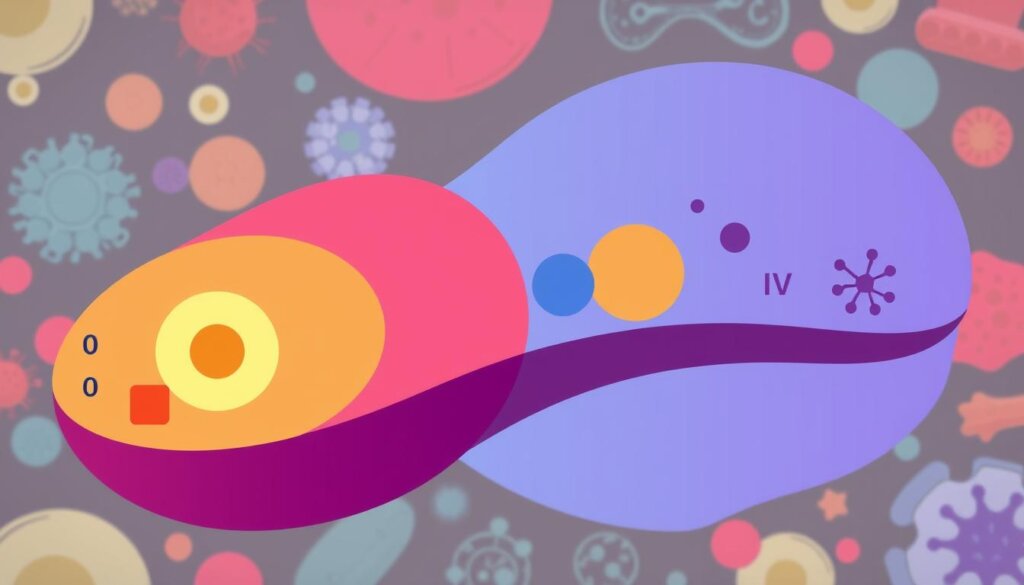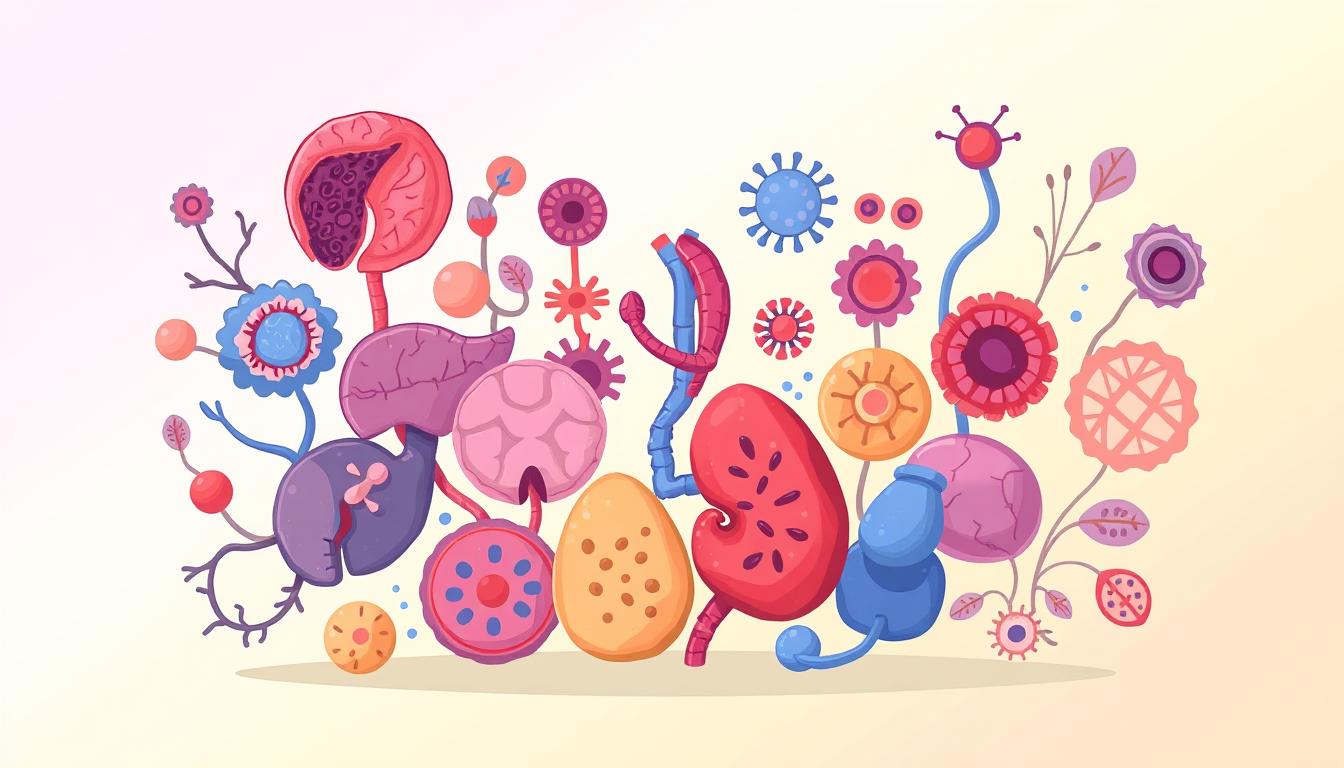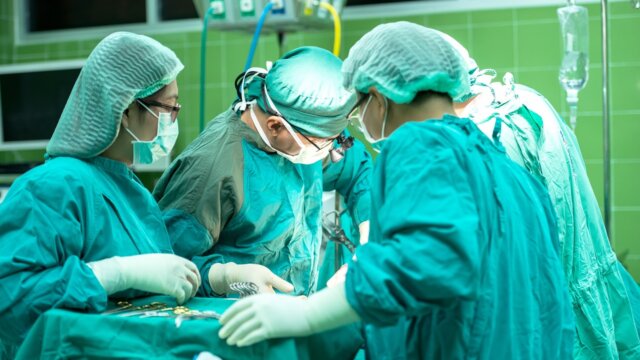FTC disclaimer: This post may contains affiliate links and we will be compensated if you click on a link and make a purchase.
Cancer hits 1 in 3 people in the U.S., showing it’s a big problem here. More people than ever are living full lives after beating cancer. This shows how far cancer care has come.
Cancer is a complex disease that can start in many parts of the body. It happens when cells grow too much and take over, making it hard for the body to work right. There are two main types: hematologic (blood) cancers like leukemia and lymphoma, and solid tumor cancers like breast and lung cancer.
Key Takeaways
- Cancer affects a significant portion of the population, with 1 in 3 people in the U.S. being affected.
- Advancements in cancer care and treatment have enabled more people to lead full lives after diagnosis.
- Hematologic (blood) cancers and solid tumor cancers are the two main categories of cancer.
- Cancer starts when cells grow out of control and crowd out normal cells, disrupting the body’s normal function.
- Understanding the different types of cancer is crucial for effective prevention, diagnosis, and treatment.
What Is Cancer?
Cancer is a disease where cells grow and spread without control. It can come from genes we get from our family or from the environment. As we get older, these changes can increase our risk of getting cancer. Each cancer is different because of its unique genetic changes.
Cancer Cells and Abnormal Growth
Cancer starts when cells grow and divide too much. These changes usually happen in our genes. Cancer cells can move to other parts of the body, creating new tumors.
Hematologic vs. Solid Tumor Cancers
There are two main types of cancer: blood cancers and solid tumors. Blood cancers include leukemia and lymphoma, while solid tumors are found in places like the breast and lung. Researchers have found ways to target cancer cells to treat the disease.
Cancer Type | Percentage of Cases |
|---|---|
Carcinomas | Most common type of cancer |
Leukemias | 3% of all cancer cases, most common in children |
Sarcomas | Less than 1% of cancer cases |
Lymphomas | About 5% of cancer cases |
Myeloma | About 2% of cancer cases |
Brain and Spinal Cord Cancers | About 3% of cancer cases |

Benign vs. Malignant Tumors
Understanding cancer starts with knowing the difference between benign and malignant tumors. Benign tumors are usually not dangerous and are not cancerous. But, some can be serious if they press on important organs or grow in key areas like the brain.
Common benign tumors include adenomas, fibromas, and lipomas. They can cause health problems if they grow too big or in the wrong place.
Malignant tumors are dangerous because they grow and spread cancer cells. Carcinomas and sarcomas are types of malignant tumors. Doctors use biopsies to check for cancer and see how far it has spread.
Benign tumors don’t invade tissues, grow slowly, and don’t spread. Malignant tumors grow fast, spread, and can invade other tissues. The most common cancers are breast, lung, and colon cancer.
Benign tumors might need to be removed if they bother nearby tissues. Some benign tumors, like colon polyps, can turn cancerous if not treated. Doctors use biopsies and tests to figure out if a tumor is benign or malignant.
Benign tumors might be watched or removed surgically. Malignant tumors need surgery, radiation, and chemotherapy. Knowing the difference helps doctors treat cancer better.

“Understanding the differences between benign and malignant tumors is crucial for accurate diagnosis and effective treatment of cancer.”
Causes and Risk Factors
Cancer is a complex disease. It can develop from genetic and environmental factors. Knowing the causes and risk factors is key to preventing and detecting cancer early.
Genetic and Environmental Factors
Genetic changes, or mutations, are a big part of cancer. These can come from parents or happen randomly in cells over time. Genetic factors cause some cancer cases. People with a family history of cancer may be at higher risk.
Environmental factors also play a big role. Carcinogens like tobacco smoke, radiation, and chemicals can damage DNA. This leads to cells growing out of control. A bad diet, not exercising, and being overweight can also raise cancer risk.
- Age is a big risk factor for cancer. As we get older, the chance of getting cancer goes up.
- Being overweight is linked to many cancers, like breast, colon, and uterine cancer.
- Tobacco use is a major risk for lung cancer.
- Drinking alcohol can increase cancer risk.
- Being exposed to harmful substances like asbestos, benzene, and radon raises cancer risk.
- Chronic inflammation in the body can also lead to cancer.
Knowing these causes and risk factors for cancer can help us take steps to lower our risk. This helps us detect cancer early and treat it better. 
“The majority of cancers are caused by environmental factors, with only a small percentage due to inherited genetic defects.” – National Cancer Institute
Staging of Cancer
Knowing the stage of cancer is key to picking the right treatment and guessing how well someone will do. The TNM system looks at Tumor size, Node involvement, and Metastasis, giving a full picture of how far the cancer has spread.
The TNM system uses numbers to show the cancer stage. Stage 1 means the tumor is small and local, and stage 4 means it has spread far away. Doctors might add letters like A, B, or C to give more details.
Staging helps decide the best treatment and tells us about the patient’s future. Early cancers might just need surgery or radiation. But cancers that have spread a lot might need stronger treatments like chemo or immunotherapy.
Tests like scans and biopsies help figure out the cancer’s stage. They show the tumor’s size, if it’s in nearby lymph nodes, and if it’s in distant places. Staging is done when cancer is first found. It might be checked again during or after treatment to see how well the cancer is responding.
Getting the cancer stage right is very important. It helps doctors choose the best treatments and gives patients a better idea of what to expect. By knowing the stage, doctors can make a plan that works best for each patient.

Cancer Stage | Tumor Characteristics | Lymph Node Involvement | Metastasis |
|---|---|---|---|
Stage 1 | Tumor size is small and localized | No lymph node involvement | No metastasis |
Stage 2 | Tumor size is larger but still localized | Some lymph node involvement | No metastasis |
Stage 3 | Tumor has grown larger and may have spread to nearby tissues | Significant lymph node involvement | No metastasis |
Stage 4 | Tumor has grown large and has spread to distant parts of the body | Lymph node involvement may be present | Metastasis to distant organs |
“Staging is a critical component of cancer care, as it helps guide treatment decisions and provide important information about a patient’s prognosis.” – Dr. Jane Doe, Oncologist
How Cancer Spreads
Cancer can spread from its primary site to other parts of the body. It does this through the bloodstream or the lymphatic system. This process is called metastasis. Cancer cells break away and travel to form new tumors in distant locations.
Metastatic cancer, or stage IV cancer, happens when the disease spreads to a different part of the body.
The lymphatic system is key in cancer spread. Lymph nodes can trap cancer cells, letting the disease spread further. While most cancer cells in the bloodstream don’t survive, a few can form secondary cancers.
Metastasis and the Lymphatic System
Cancer cells spread through several steps. They invade nearby tissues, travel through lymphatics and blood vessels, establish new tumors, and grow a new blood supply. Metastasis often happens in the bone, liver, and lung. But, the exact sites depend on the cancer type.
- Bladder cancer often spreads to the bones, liver, or lungs.
- Breast cancer commonly spreads to the bones, brain, liver, or lungs.
- Lung cancer frequently spreads to the adrenal glands, bones, brain, liver, or the other lung.
The location and type of cancer cells affect metastasis patterns. For example, breast cancer usually goes to underarm lymph nodes but rarely to belly lymph nodes. Gene mutations and the tumor microenvironment also influence spread and survival in different organs.
Symptoms of metastatic cancer vary based on tumor size and location. Treatment aims to slow disease growth. Palliative care improves quality of life. Discussions about end-of-life care are recommended when the disease can’t be controlled.
Types of Cancer
Cancer is a complex disease with over 100 different types. Each type comes from different cells in the body. The most common type is carcinoma, making up about 90% of all cancers.
Carcinomas start in the skin or the lining of organs. They can be squamous cell, adenocarcinoma, transitional cell, or basal cell carcinoma.
Sarcomas are rare tumors in connective tissues like bone or muscle. They are much less common than carcinomas.
The Burden of Cancer
Cancer is a big health problem, with over a million cases in the U.S. each year. Sadly, more than 500,000 Americans die from it yearly. Worldwide, cancer caused nearly 10 million deaths in 2020, with breast, lung, and colorectal cancers being the most common.
Cancer Type | New Cases (2020) | Deaths (2020) |
|---|---|---|
Breast | 2.26 million | N/A |
Lung | 2.21 million | 1.80 million |
Colon and Rectum | 1.93 million | 916,000 |
Despite the challenge, cancer death rates have dropped by 33% in the U.S. since 1991. Ongoing research is crucial to fight this disease.
“Between 30% and 50% of cancers can be prevented by avoiding risk factors and implementing evidence-based prevention strategies.”
Leukemias and Lymphomas
Leukemia and lymphoma are two types of blood cancers. They start in the immune system’s cells. Leukemia begins in white blood cells, making them crowd out healthy ones. Lymphoma starts in the lymphatic system, which fights off infections.
Lymphomas can grow in lymph nodes, spleen, or other tissues. There are big differences between leukemia and lymphoma. Acute lymphoblastic leukemia (ALL) is common in kids. Acute lymphoblastic leukemia and acute myeloid leukemia grow fast. Chronic lymphocytic leukemia (CLL) and chronic myeloid leukemia (CML) grow slowly.
Chronic leukemias mostly hit older people. Acute leukemias often affect kids and older people. Lymphoblastic/lymphocytic leukemias and myeloid leukemias start in different cells.
Hodgkin lymphoma and Non-Hodgkin lymphoma spread differently. B-cell lymphomas make up most Non-Hodgkin lymphomas. Knowing the differences is key for the right treatment.
Medical research and treatments have improved a lot. About 80% of kids with ALL can be cured. Stem cell and bone marrow transplants save lives for some.
Type of Blood Cancer | Key Features |
|---|---|
Leukemia |
|
Lymphoma |
|
People with blood cancers get help at cancer centers. The University of Mississippi Medical Center (UMMC) is a top place for care. They offer stem cell transplants and blood banking support.
Brain and Spinal Cord Cancers
The brain and spinal cord can have cancerous growths. Gliomas and nerve cell tumors are common types.
Gliomas and Nerve Cell Tumors
Gliomas start from glial cells in the brain. These cells support nerve cells. Gliomas can be slow-growing and non-cancerous or fast-growing and cancerous.
Glioblastoma multiforme is a fast-growing, cancerous glioma. It often comes back after treatment.
Nerve cell tumors also start from nerve cells. They can be slow-growing and non-cancerous or fast-growing and cancerous.
Brain and spinal cord cancers are hard to treat. But, medical research and treatments are getting better. Knowing about these cancers helps in managing them better.
“Gliomas are the most common type of primary brain tumor, accounting for about 80% of all malignant brain tumors.”
Brain and spinal cord cancers can greatly affect a person’s life. Getting medical help quickly and working with healthcare teams is key.
Type of Brain/Spinal Cord Cancer | Incidence |
|---|---|
Glioblastomas (GBMs) | More than half of all gliomas and the most common malignant brain tumor in adults |
Astrocytomas | About 2 out of 10 brain tumors |
Oligodendrogliomas | Only about 1% to 2% of brain tumors |
Ependymomas | Represent about 2% of brain tumors |
Meningiomas | Account for about 1 out of 3 primary brain and spinal cord tumors |
Medulloblastomas | Much more common in children than in adults |
Schwannomas | Make up about 8% of all central nervous system tumors |
Craniopharyngiomas | More common in children but sometimes seen in adults |
Conclusion
Cancer is a complex disease with many types. Each type needs its own approach to prevention and treatment. Knowing how cancer starts and grows helps you protect your health and find cancer early.
In 2019, 24 million new cancer cases were reported worldwide. This led to 10 million deaths. But, thanks to medical progress, survival rates have improved. In the U.S., the five-year survival rate is now 66%.
Knowing the risks like tobacco use, infections, and genetic factors helps prevent cancer. These factors cause 22%, 16-18%, and 5-10% of cancer deaths, respectively. Understanding cancer types and characteristics helps you find the right treatment.
The cost of cancer worldwide is huge, at $1.16 trillion a year. It’s crucial to have affordable and fair cancer care. Efforts in early detection, palliative care, and raising awareness are key. They help improve life for those with cancer.
By staying informed and proactive, you can help fight cancer. You can make a big difference in creating a healthier future for everyone.
FAQ
What is cancer?
Cancer is a disease where cells grow and divide too much. This makes it hard for the body to work right.
What are the main types of cancer?
Cancer is mainly divided into two types. Hematologic cancers affect the blood and immune system. Solid tumor cancers grow in specific body parts like the breast or lung.
What is the difference between benign and malignant tumors?
Benign tumors are not cancer and grow slowly. They don’t spread and can usually be removed. Malignant tumors are cancerous and grow fast. They spread and need strong treatment.
What causes cancer?
Cancer comes from genetic and environmental factors. Genetic changes can be inherited or happen randomly. Environmental factors like tobacco smoke and chemicals also play a role.
How is cancer staged?
Cancer is staged by testing its size and spread. Lower stages mean it has spread little, and higher stages mean it has spread more.
How does cancer spread?
Cancer spreads through the bloodstream or lymphatic system, a process called metastasis. Cancer cells can travel and form new tumors.
What are the different types of cancer?
There are over 200 types of cancer. They start from different cells. Carcinoma is the most common, starting in skin or internal organs.
What are leukemias and lymphomas?
Leukemia and lymphoma are blood cancers. Leukemia affects white blood cells. Lymphoma starts in the lymphatic system.
What are brain and spinal cord cancers?
These cancers start in the brain or spinal cord. The most common brain tumor is a glioma. It comes from glial cells that protect nerve cells.








